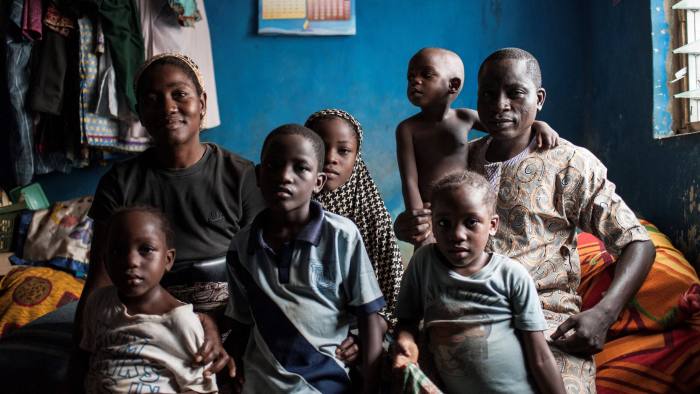Breaking News
In February, Nigeria Overtakes India As Country With Most Poor People In The World

Amani Amos with his wife and five children in their one-bedroom flat in Lagos, Nigeria. The country’s population is growing faster than its economy, meaning poverty is likely to increase © AFP
An estimated 47m people, almost equivalent to the population of Colombia, are likely to escape extreme poverty this year. But that will not be enough to get anywhere near the UN’s Sustainable Development Goal of ending extreme poverty — defined as living on less than $1.90 a day at 2011 purchasing power parity prices — by 2030.
Financial Times reports that, by 2030, there will be 200m fewer people living in extreme poverty than there are today. However, 438m, or 5 per cent of the world’s population, will still be below the extreme poverty line.
These are the latest forecasts of the World Poverty Clock, a project launched in May by World Data Lab, a non-governmental organisation in Vienna funded by the German government and led by Homi Kharas, deputy director of the Brookings Institution in the US, and Wolfgang Fengler, a World Bank lead economist.
The clock, which has just had its first twice-yearly update, predicts that the net global reduction in extreme poverty is falling short by 9.5m people per year compared with what is needed to meet the SDG. This year, for example, the extreme poverty level is rising in 30 countries; in these nations a total of 9m more people will be living in extreme poverty at the end of 2017 than 12 months previously.
“Very few countries in Africa are making fast enough progress on ending poverty, and in two large countries, Nigeria and the Democratic Republic of Congo, their populations are growing faster than their economic growth, so poverty will likely continue to rise,” Mr Kharas said. “We need a dramatic break from current trends in over 30 countries in order to end poverty worldwide.”
Nigeria’s population in extreme poverty is rising by 5.7 people per minute and that in DRC by 3.6 people per minute. The rest of Africa is reducing poverty by 4.7 people per minute. The situation in Nigeria is such that in February next year it will overtake India as having the most people living in extreme poverty in the world, at 82m, the clock predicts. The forecasts are compiled from hundreds of data sets, including figures from national governments, the International Monetary Fund and the World Bank.
Mr Kharas said it was important to address the challenge, “not in global terms, and instead to look at it country-by-country”. “We may be able to accept that small pockets of poverty remain in some countries — in fact some poverty is present even in the richest countries — but we want to avoid any individual countries, even ones with small populations, being in deep poverty,” he said.
The UN’s SDG is unlikely to be met because, globally, the rate of poverty reduction is slowing — largely on account of Asia getting close to ending extreme poverty. Meanwhile, many parts of Africa are making insufficient progress, the clock reveals.
The extreme poverty rate in Africa will drop from 34 per cent this year to 23 per cent in 2030, the clock predicts. But the absolute number is likely to be only slightly lower than what it is now because of population growth.
The clock, which uses myriad data sets to produce real-time figures, has already provided some “surprising results”, Mr Kharas said. “For example, Madagascar will be the third-poorest country in terms of the number of people living in extreme poverty in 2030. So if I was in a development co-operation agency I’d be thinking, ‘Let’s make sure we are focusing on where the challenges are toughest’,” he said.
The next goal for the clock’s team is to produce sub-national extreme poverty data. The first prototype, for Kenya, will be launched this month, with Indonesia and Pakistan likely to be next. Mr Fengler said Kenya was chosen for several reasons: it has sufficient open data to produce credible statistics; there are enough qualified people to analyse the figures; and, following the devolution of many government functions to the 47 counties in 2013, it has the political units to make such an exercise relevant. “It’s all about how you can make data relevant in real time and plan for the future, and worry less about the past,” he added.






